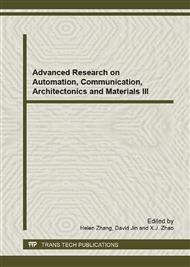p.67
p.73
p.78
p.83
p.87
p.92
p.97
p.103
p.109
Effect of Triethanolamine Addition in Alkaline Bath on the Electroplating Behavior, Composition and Corrosion Resistance of Zn-Ni Alloy Coatings
Abstract:
Zn-Ni alloy coatings were electrodeposited on low carbon steel substrate using a cyanide-free alkaline bath containing tetraethylenepentamine (TEPA) and triethanolamine (TEA) as complexing agents for Ni2+ cations. Effect of TEA/Ni2+ molar ratio on electrodeposition behavior, micromophology, Ni content and corrosion resistance of coatings were studied by means of SEM/EDS, polarization curve and electrochemical impedance spectroscopy (EIS), respectively. It was found that the deposition potential and elecctrochemical impedance of the cathode sample during the electrodeposition was influenced by the TEA/Ni2+ molar ratio (TNmr) in the bath. The deposition potential shifts negatively and the impedance rises with increasing TNmr up to 2. The nickel content in Zn-Ni deposit was varied in a range from 16.81 to 19.04 wt.%. The dependence of cathodic current efficiency and depositing velocity of the coating on TNmr of plating bath were also determined. A fine-grained and smooth-faced coating was obtained at TNmr =2, which exhibited the highest corrosion resistance in 3.5% NaCl environment.
Info:
Periodical:
Pages:
87-91
Citation:
Online since:
August 2013
Authors:
Price:
Сopyright:
© 2013 Trans Tech Publications Ltd. All Rights Reserved
Share:
Citation:


